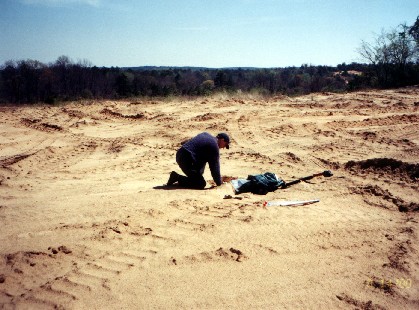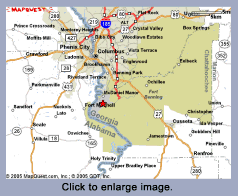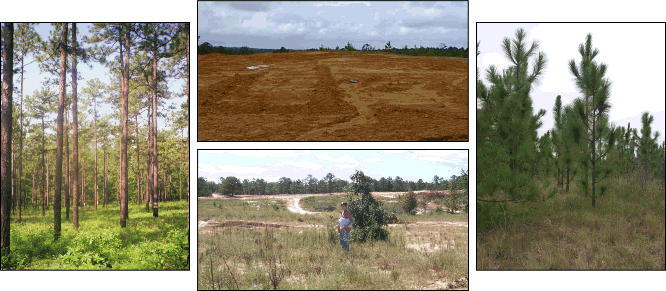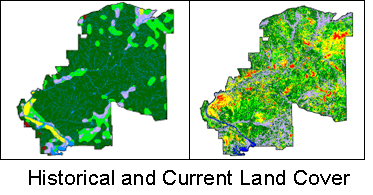

Utilizing Indicators of Ecological Change

September 2004 Presentation 
Principal Investigator
Virginia H. Dale
Environmental Sciences Division
Oak Ridge National Laboratory
Other Participants
Stream Macroinvertebrates
Jack Feminella and Kelly Maloney
Department of Biological Sciences
Auburn University
Historical Land Cover
Thomas Foster
Panamerican Consultants, Inc.
Aquatic Ecology
Patrick Mulholland
Environmental Sciences Division
Oak Ridge National Laboratory
Geographic Information and Landscape Analysis
Latha Baskaran and Lisa Olsen
Environmental Sciences Division
Oak Ridge National Laboratory
Soil Microbiology
David White, Aaron Peacock, and James Cantu
Center for Biomarker Analysis
University of Tennessee
Terrestrial and Landscape Indicators
Virginia Dale and Dan Druckenbrod
Environmental Sciences Division
Oak Ridge National Laboratory
Background
 The SERDP Ecosystem Management Program (SEMP) selected this project to help identify indicators of ecosystem change focusing on the test site of Fort Benning, Georgia, with the intent that the ideas would be applicable across the diverse properties of the Department of Defense (DoD). Click here to view this project's quarterly and annual reports.
The SERDP Ecosystem Management Program (SEMP) selected this project to help identify indicators of ecosystem change focusing on the test site of Fort Benning, Georgia, with the intent that the ideas would be applicable across the diverse properties of the Department of Defense (DoD). Click here to view this project's quarterly and annual reports.
Objectives
- To identify indicators that signal ecological change in intensely versus lightly used ecological systems
- To ensure that these indicators are feasible for the installation staff to measure and interpret and thus can become a part of the ongoing monitoring system at the installation

These are images of different areas within Ft. Benning that have had different levels of disturbance: Left) Reference Fores; Center Top) Marginal disturbance due to vehicles; Center Bottom) Significant disturbance due to vehicle; and Right) Restored forest.
Technical Approach
- Analyze historical trends in environmental changes to identify potential indicators
- Collect supplemental data relating to proposed indicators (building upon existing data)
- Perform experiments to examine how training affects indicators
- Analyze resulting set of indicators for appropriateness, usefulness, and ease of taking the measure
- Develop and implement a technology transfer plan

Outreach
The participants of this study are conducting outreach meetings with the local government officials, chamber of commerce members, and other community leaders in order to share their findings and receive input as to how these findings can be best utilized in the public sector for developing ecologically sensitive land use plans.
Products/Papers (Full list of products  )
)
- Beyeler, S.C. 2000. Ecological indicators. Master’s thesis. University of Miami in Ohio.
- Black, B.A., H. T. Foster, and M.D. Abrams. 2002. Combining environmentally dependent and independent analysis of witness tree data in east-central Alabama. Canadian Journal of Forest Research 32: 2060-2075.
- Dale, V.H. and Beyeler, S.C. 2001. Challenges in the development and use of ecological indicators. Ecological Indicators 1: 3-10. pdf file
- Dale, V.H., Beyeler, S.C., and Jackson, B. 2002. Understory indicators of anthropogenic disturbance in longleaf pine forests at Fort Benning, Georgia, USA. Ecological Indicators 1(3): 155-170. pdf file
- Dale, V H., Mulholland, P., Olsen, L. M., Feminella, J., Maloney, K., White, D. C., Peacock, A., and Foster, T., “Selecting a Suite of Ecological Indicators for Resource Management,” Landscape Ecology and Wildlife Habitat Evaluation: Critical Information for Ecological Risk Assessment, Land-Use Management Activities and Biodiversity Enhancement Practices, ASTM STP 11813, L. A. Kapustka, H. Gilbraith, M. Luxon, and G. R. Biddinger, Eds., ASTM International, West Conshohocken, PA, 2004.
- Foster, H.T., II. 2001. Long term average rate maximization of Creek Indian residential mobility a test of the marginal value theorem. Ph.D. dissertation, Department of Anthropology, Pennsylvania State University.
- Foster, Thomas, Bryan Black, and Marc Abrams. 2004. A witness tree analysis of the effects of Native American Indians on the pre-European settlement forests in east central Alabama. Human Ecology 32 (1).
- Black, Bryan, Thomas Foster, and Marc D. Abrams. 2002. Combining environmentally dependent and environmentally independent analysis of witness tree data in East-Central Alabama. Canadian Journal of Forestry Research 32 (11): 2060-2075.
- Peacock, A. D., S. J. MacNaughton, J. M. Cantu, V. H. Dale and D. C. White. 2001. Soil microbial biomass and community composition along an anthropogenic disturbance gradient within a longleaf pine habitat. Ecological Indicators 1(2):113-121. pdf file
Links to Other Sites on Ecological Indicators
Top of Page | ESD SERDP Home | Comments | Disclaimers
March 28, 2005




 The SERDP Ecosystem Management Program (SEMP) selected this project to help identify indicators of ecosystem change focusing on the test site of Fort Benning, Georgia, with the intent that the ideas would be applicable across the diverse properties of the Department of Defense (DoD). Click here to view this project's quarterly and annual reports.
The SERDP Ecosystem Management Program (SEMP) selected this project to help identify indicators of ecosystem change focusing on the test site of Fort Benning, Georgia, with the intent that the ideas would be applicable across the diverse properties of the Department of Defense (DoD). Click here to view this project's quarterly and annual reports.

 )
)